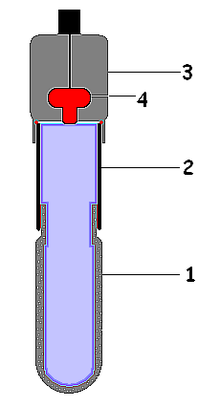Tensiometer (soil moisture)
Tensiometers are used to continuously measure soil moisture based on the suction tension . The drier the soil, the greater the potential of the adsorption and capillary forces that bind the water in the soil. Depending on the design, tensiometers can record suction stresses from 0 to approx. −850 hPa .
Measuring principle
The soil moisture is measured via the suction tension , i.e. the drying out of a soil. The measurement is carried out using a water-filled, airtight, porous ceramic cell (“ceramic candle”) (1) with a maximum pore diameter of approx. 1 µm, which is placed in the ground. A transparent plastic tube (2) is used to check the fill level. Degassed water is used for filling, which can also be colored if required.
When the soil around the ceramic cell dries out, enough water is "drawn" from the ceramic cell until an equilibrium with the surrounding soil water is reached. The resulting negative pressure is displayed on a manometer or can be electronically processed using a pressure sensor (4).
Applications
In soil physical investigations, tensiometers can be used to continuously measure the water balance in the soil at different depths. In agriculture and horticulture, tensiometers are used in the automation of irrigation systems. The amount of water can be controlled so that the plants are optimally supplied with water without water and nutrients being washed out into the subsoil.
advantages
The measurement takes place independently of the salt content (e.g. from fertilizer salts) in the soil or plant substrate and directly measures the availability of the soil water for the plants at the site. The method is not directly dependent on the nature of the soil, temperature and other influencing variables - also independent of the absolute amount of water - and thus offers a good measurement variable for the automatic control of irrigation systems.
disadvantage
Tensiometers only measure selectively. The soil moisture can take on completely different values at a different depth or a few centimeters away. The choice of a representative measuring location is therefore crucial. If necessary, water must be refilled with tensiometers. This is especially true for measurements in dry soils or substrates. For outdoor applications, year-round measurements are only possible at a frost-proof depth or when substances such as polyethylene glycol (PEG) are added.
Another limitation is the limited measuring range of tensiometers filled with water. To extend the measuring range, osmotic tensiometers with a semi-permeable membrane and PEG as a filling are used.
See also
- Tensio switch or switch tensiometer
- Capacitive_Sensor # moisture meter
- irrigation
- Drip irrigation
- Lysimeter
- Capillary meter
literature
- F.-W. Frenz: Control options for irrigation systems. In: Irrigation in Horticulture. Landwirtschaftsverlag, Münster-Hiltrup 1988, ISBN 3-7843-1771-5 , pp. 115-124 ( KTBL-Schrift 328).
- F. Möckel: Development of an electronic tensiometer with an analog output and a downstream switching amplifier, taking into account soil-physical criteria. Diploma thesis at the Weihenstephan University of Applied Sciences in 1989.
- SL Rawlins: Measurement of Water Content and the State of Water in Soils . In: Water Deficits and Plant Growth. 4, 1976, ZDB ID 741684-2 , pp. 1-47.
